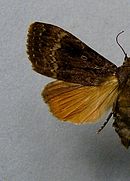Svensson's pyramid owl
| Svensson's pyramid owl | ||||||||||||
|---|---|---|---|---|---|---|---|---|---|---|---|---|

Svensson's pyramid owl ( Amphipyra berbera ) |
||||||||||||
| Systematics | ||||||||||||
|
||||||||||||
| Scientific name | ||||||||||||
| Amphipyra berbera | ||||||||||||
| Rungs , 1949 |
Svensson's pyramid owl ( Amphipyra berbera ) is a butterfly ( moth ) from the owl butterfly family (Noctuidae). The German name honors the Swedish lepidopterist Ingvar Svensson , who recognized the independence of the species in the late 1960s. Because of this relatively late discovery, the species was sometimes referred to as the "overlooked pyramid owl".
features
butterfly
The moths reach a wingspan of 49 to 53 millimeters. They have gray-brown patterned forewings on which part of the central area is colored black. This is limited by a yellow and white inner and outer transverse line. A white, black core ring flaw can be seen in the middle field. The hind wings are copper-red, lighter colored towards the front edge. It is very similar to the pyramid owl ( Amphipyra pyramidea ). The following table lists the main distinguishing features: Although not all the listed distinguishing features are always present in all specimens at the same time, a sufficient number can usually be identified for a reliable determination.
|
pyramidea |
berbera |
|
|---|---|---|
| Ring flaws small, sometimes absent | Ring flaws always large and very clear | |
| Entire midfield darkened | Small part of the midfield darkened | |
| Field between the ring flaw and the inner transverse line, diamond-shaped | Rectangular field between ring spot and inner transverse line | |
| Inner transverse line mostly indistinct, outer transverse line lighter | Inner transverse line clear and of the same color as the outer transverse line | |
| Outer transverse line relatively straight | The outer transverse line runs diagonally towards the rear edge | |
| Hind wings strong copper-red | Hind wings light copper-red | |
| Contrasting hind wing underside | Hind wing underside washed out and poor in contrast |
Caterpillar
The caterpillars are green in color and have many white dots and lines spread over the body. At the level of the spiracles there is a continuous whitish side line that is darkly bordered at the top. At the end of the abdomen there is a clear pyramidal hump on which a white line runs to the mostly red tip. The following table lists the main distinguishing features from the similar pyramid owl: Although not all the distinguishing features listed are always present in all specimens at the same time, a sufficient number can usually be recognized for a reliable determination.
|
pyramidea |
berbera |
|
|---|---|---|
| Basic color blue-green | Basic color yellow-green | |
| Side strips on segment 4 and 5 interrupted | Continuous side stripes | |
| Side stripes delimited slightly blackish upwards | Side stripes bordered strongly blackish upwards | |
| Body covered with small white dots | Body covered with many white dots and lines | |
| Sternum green | Sternum mostly black | |
| Cusp tip green or slightly reddish | Cusp tip red |
Geographical distribution and occurrence
The species occurs from northwest Africa across Europe to Asia Minor and the Caucasus region. Since the separation of Amphipyra pyramidea took place late, further investigations are necessary to complete the entire distribution area. In the Alps it can still be found above the tree line . It lives mainly in mixed and deciduous forests as well as in park landscapes.
Way of life
Svensson's pyramid owl forms a generation a year that flies from early July to early October. It appears two weeks earlier than the pyramid owl. The nocturnal moths like to visit artificial bait in large numbers . The caterpillars can be found from May to early July. They feed on the leaves of deciduous trees. So far, hawthorn ( Crataegus ) and linden ( Tilia ) species have been identified. When breeding, they also take lilac leaves ( Syringa ) as food. The species overwinters as an egg.
Danger
Svensson's pyramid owl occurs in all German federal states and is classified as not endangered on the Red List of Endangered Species .
Taxonomy
The species was first identified as a North African subspecies of Amphipyra pyramidea , d. H. as ssp. berbera viewed. Due to habitual and genital morphological differences, however, it was recognized as an independent species.
swell
Individual evidence
- ↑ a b Michael Fibiger, Hermann Hacker: Amphipyrinae, Condicinae, Eriopinae, Xyleninae (part) . In: Michael Fibiger, László Ronkay, Barry Goater, Martin Honey (eds.): Noctuidae Europaeae . tape 9 . Entomological Press, Sorø 2007, ISBN 978-87-89430-11-9 (English).
- ↑ a b c d Günter Ebert (Ed.): The butterflies of Baden-Württemberg . 1st edition. tape 6 . Moth IV. Noctuidae 2nd part. Ulmer, Stuttgart (Hohenheim) 1997, ISBN 3-8001-3482-9 .
- ↑ Ernst Urbahn : Amphipyra pyramedea and Amphipyra berbera - two indistinguishable native noctuids. Entomological News, Volume 12, 1968
- ↑ a b Ernst Urbahn: Differences in the caterpillar stands of Amphipyra pyramidea L. and A. berbera svenssoni Fletcher , Notuale Entomologicae XLIX., Pp247-253, 1969
- ^ F. Lichtenberger, The spread of Amphipyra berbera svenssoni FLETCHER in Austria , journal of the Österr working group. Entomologists, Vol. 40, 3/4, 1988 (1989)
- ↑ Federal Agency for Nature Conservation (Ed.): Red List of Endangered Animals in Germany . Landwirtschaftsverlag, Münster 1998, ISBN 3-89624-110-9 .
literature
- Michael Fibiger, Hermann Hacker: Amphipyrinae, Condicinae, Eriopinae, Xyleninae (part) . In: Michael Fibiger, László Ronkay, Barry Goater, Martin Honey (eds.): Noctuidae Europaeae . tape 9 . Entomological Press, Sorø 2007, ISBN 978-87-89430-11-9 (English).
- Günter Ebert (Ed.): The butterflies of Baden-Württemberg . 1st edition. tape 6 . Moth IV. Noctuidae 2nd part. Ulmer, Stuttgart (Hohenheim) 1997, ISBN 3-8001-3482-9 .
Web links
- Lepiforum eV photos
- www.pyrgus.de Photos and ecology
- www.schmetterlinge-deutschlands.de Endangerment
- Amphipyra berbera at Fauna Europaea. Retrieved September 15, 2011


